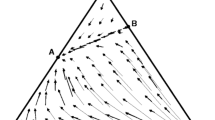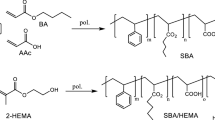Abstract
An experimental study shows how the emulsion terpolymerization of lauryl methacrylate (LMA) and methyl methacrylate is influenced by the nature of the third monomer. The third monomer is either glycidyl methacrylate, hydroxyethyl methacrylate, hydroxypropyl methacrylate, or styrene. We report the synthesis of terpolymer particles with an appreciably high content of the very hydrophobic LMA (between 0.2515 and 0.238 molar fraction in the monomer mixture) in 60:40 weight water/ethanol mixture as the continuous phase, poly(vinyl pyrrolidone) as a polymeric steric stabilizer, and potassium peroxodisulfate as the initiator. The emulsion terpolymerization proceeds smoothly without the formation of coagulum and leads to particles with an average diameter clearly below 1 μm. We discuss the overall polymerization behavior regarding conversion–time curves, particle morphology, and glass transition temperature of the terpolymers in dependence of the lyophilicity/lyophobicity of the monomer mixture.








Similar content being viewed by others
References
Hernandez HF, Tauer K (2002) In: Schlüter AD, Hawker CJ, Sakamoto J (eds) Synthesis of polymers. Wiley-VCH, Weinheim, pp 741–773
Lau W (2002) Emulsion polymerization of hydrophobic monomers. Macromol Symp 182:283–289
Tauer K, Ali AMI, Yildiz U, Sedlak M (2005) On the role of hydrophilicity and hydrophobicity in aqueous heterophase polymerization. Polymer 46:1003–1015
Xu WJ, Zhu XL, Cheng ZP, Chen JY (2003) Atom transfer radical polymerization of lauryl methacrylate. J Appl Polym Sci 90:1117–1125
Xu YY, Becker H, Yuan JY, Burkhardt M, Zhang Y, Walther A, Bolisetty S, Ballauff M, Muller AHE (2007) Double-grafted cylindrical brushes: synthesis and characterization of poly(lauryl methacrylate) brushes. Macromol Chem Phys 208:1666–1675
Lindner K, Saenger W (1982) Crystal and molecular-structure of cyclohepta-amylose dodecahydrate. Carbohydrate Res 99:103–115
Schneiderman E, Stalcup AM (2000) Cyclodextrins: a versatile tool in separation science. J Chromatogr B 745:83–102
Loftsson T, Brewster ME (1996) Pharmaceutical applications of cyclodextrins. 1. Drug solubilization and stabilization. J Pharm Sci 85:1017–1025
Islam MF, Jenkins RD, Bassett DR, Lau W, Ou-Yang HD (2000) Single chain characterization of hydrophobically modified polyelectrolytes using cyclodextrin/hydrophobe complexes. Macromolecules 33:2480–2485
Leyrer RJ, Machtle W (2000) Emulsion polymerization of hydrophobic monomers like stearyl acrylate with cyclodextrin as a phase transfer agent. Macromol Chem Phys 201:1235–1243
Meyer EE, Islam MF, Lau W, Ou-Yang HD (2000) Complexation kinetics of cyclodextrin with hydrophobic molecules confined in an isolated droplet in water. Langmuir 16:5519–5525
Rimmer S, Tattersall PI (1999) The inclusion of beta cyclodextrin provides a supramolecular solution to the problem of polymerization of dodecyl and octadecyl methacrylates in aqueous emulsion. Polymer 40:5729–5731
Rimmer S, Tattersall PI (1999) Emulsion polymerizations in the presence of beta-cyclodextrin. Polymer 40:6673–6677
Rimmer S (2000) Cyclodextrins in the emulsion polymerization of vinyl monomers. Macromol Symp 150:149–154
You X, Dimonie VL, Klein A (2001) Kinetic study of emulsion copolymerization methacrylate/lauryl methacrylate in propylene glycol, stabilized with poly(ethylene oxide)-block-polystyrene-block-poly(ethylene oxide) triblock copolymer. J Appl Polym Sci 82:1691–1704
Habibi A, Vasheghani-Farahani E, Semsarzadeh MA, Sadaghiani K (2004) Estimation of monomer reactivity ratios in free radical solution copolymerization of lauryl methacrylate–isobutyl methacrylate. J Polym Sci Part A Polym Chem Ed 42:112–129
Choi EM, Shin KS, Hwang TS (2010) Synthesis and electrochemical properties of ion exchange membrane based on crosslinked styrene-(2-hydroxyethyl acrylate)-lauryl methacrylate copolymer. Macromol Res 18:1209–1217
Abere J, Goldfinger G, Naidus H, Mark H (1945) Polymerization of styrene under various experimental conditions. J Phys Chem 49:211–226
Yosida T, Titani T (1941) Polymerisation von Styrol in schwerem Alkohot. Bull Chemi Soc Japan 16:125–136
Chern C-S, Yu T-C (2005) Effect of 1-pentanol on the styrene emulsion polymerization. Polymer 46:1899–1904
Ahmad H, Hasan MK, Miah MAJ, Ali AMI, Tauer K (2011) Solvent effect on the emulsion copolymerization of methyl methacrylate and lauryl methacrylate in aqueous media. Polymer 52:3925–3932
Ahmad H, Abu-Waesmin M, Rahman MM, Miah MAJ, Tauer K (2013) Preparation of hydrophobic polymer particles by radical polymerization and subsequent modification into magnetically doped particles. J Appl Polym Sci 127:620–627
Jin JM, Lee JM, Ha MH, Lee K, Choe S (2007) Highly crosslinked poly(glycidyl methacrylate-co-divinyl benzene) particles by precipitation polymerization. Polymer 48:3107–3115
Asua JM, Beuermann S, Buback M, Castignolles P, Charleux B, Gilbert RG, Hutchinson RA, Leiza JR, Nikitin AN, Vairon JP, van Herk AM (2004) Critically evaluated rate coefficients for free-radical polymerization. 5. Propagation rate coefficient for butyl acrylate. Macromol Chem Phys 205:2151–2160
Buback M, Kurz CH (1998) Free-radical propagation rate coefficients for cyclohexyl methacrylate, glycidyl methacrylate and 2-hydroxyethyl methacrylate homopolymerizations. Macromol Chem Phys 199:2301–2310
Hutchinson RA, Beuermann S, Paquet DA, McMinn JH, Jackson C (1998) Determination of free-radical propagation rate coefficients for cycloalkyl and functional methacrylates by pulsed-laser polymerization. Macromolecules 31:1542–1547
Daubert TE, Danner RP, Sibul HM, Stebbins CC (1998) Physical and thermodynamic properties of pure chemicals: data compilation. Taylor and Francis, Washington
Tauer K (2005) Stability of monomer emulsion droplets and implications for polymerizations therein. Polymer 46:1385–1394
Andrews RJ, Grulke EA (1999) In: Brandrup J, Immergut EH, Grulke EA (eds) Polymer handbook (chapter 6). Wiley, New York, p 193
Peyser P (1989) In: Brandrup J., Immergut EH (eds) Polymer handbook (chapter 6). Wiley, New York, p 209
Allen PEM, Downer JM, Hastings GW, Melville HW, Molyneux P, Urwin JR (1956) New methods of preparing block copolymers. Nature 177:910–912
Acknowledgments
The authors thank Mrs. Rona Pitschke and Mrs. Heike Runge of MPI of Colloid and Interfaces for providing SEM micrographs.
Author information
Authors and Affiliations
Corresponding authors
Rights and permissions
About this article
Cite this article
Shabnam, R., Ali, A.M.I., Miah, M.A.J. et al. Influence of the third monomer on lauryl methacrylate–methyl methacrylate emulsion terpolymerization. Colloid Polym Sci 291, 2111–2120 (2013). https://doi.org/10.1007/s00396-013-2952-7
Received:
Revised:
Accepted:
Published:
Issue Date:
DOI: https://doi.org/10.1007/s00396-013-2952-7




